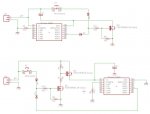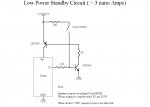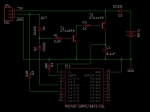Hemi345
Senior Member
I remember reading a topic about this but can't seem to find it again.
I'm designing a toy for my daughter who likes to leave things on and run the batteries dead. I want to power it off automatically a short time after she's finished playing with it.
My plan is to have her press the momentary switch to pull the gate on the n-channel mosfet high to connect the Picaxe circuit. Once the Picaxe powers on, the initialize routine would put pin B.3 high and keep the Picaxe powered. I'll use a counter to detect when the device has been idle for ~10 minutes, then put B.3 low which would power it off.
In the attached schematic, there are two circuits. Would the first circuit work fine (the one on top without the p-channel mosfet)?
Thanks.
I'm designing a toy for my daughter who likes to leave things on and run the batteries dead. I want to power it off automatically a short time after she's finished playing with it.
My plan is to have her press the momentary switch to pull the gate on the n-channel mosfet high to connect the Picaxe circuit. Once the Picaxe powers on, the initialize routine would put pin B.3 high and keep the Picaxe powered. I'll use a counter to detect when the device has been idle for ~10 minutes, then put B.3 low which would power it off.
In the attached schematic, there are two circuits. Would the first circuit work fine (the one on top without the p-channel mosfet)?
Thanks.
Attachments
-
51.3 KB Views: 187



